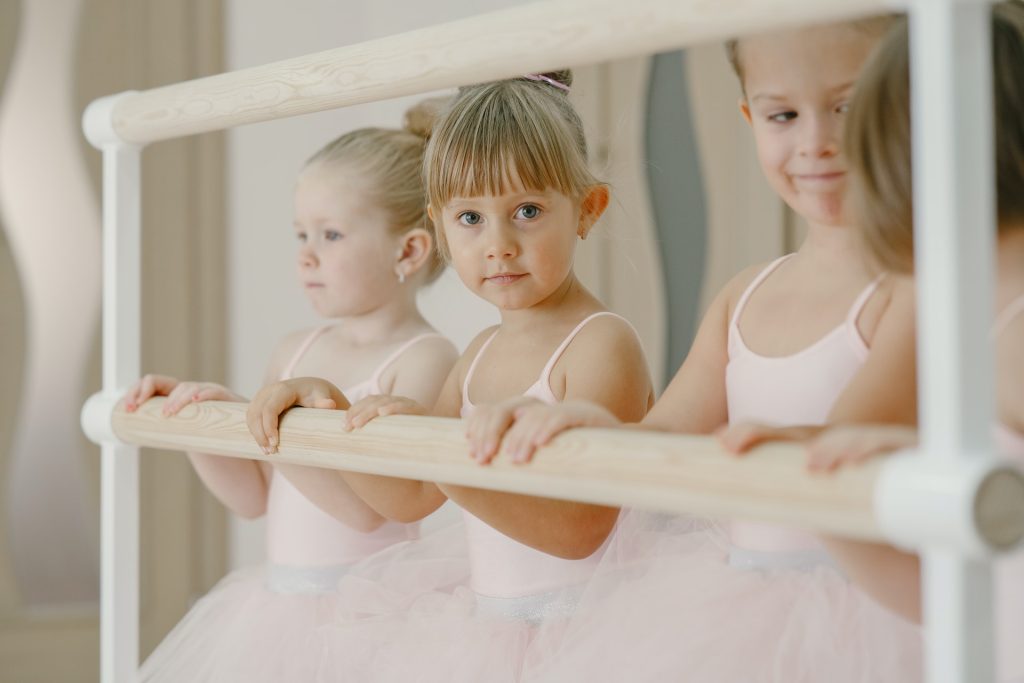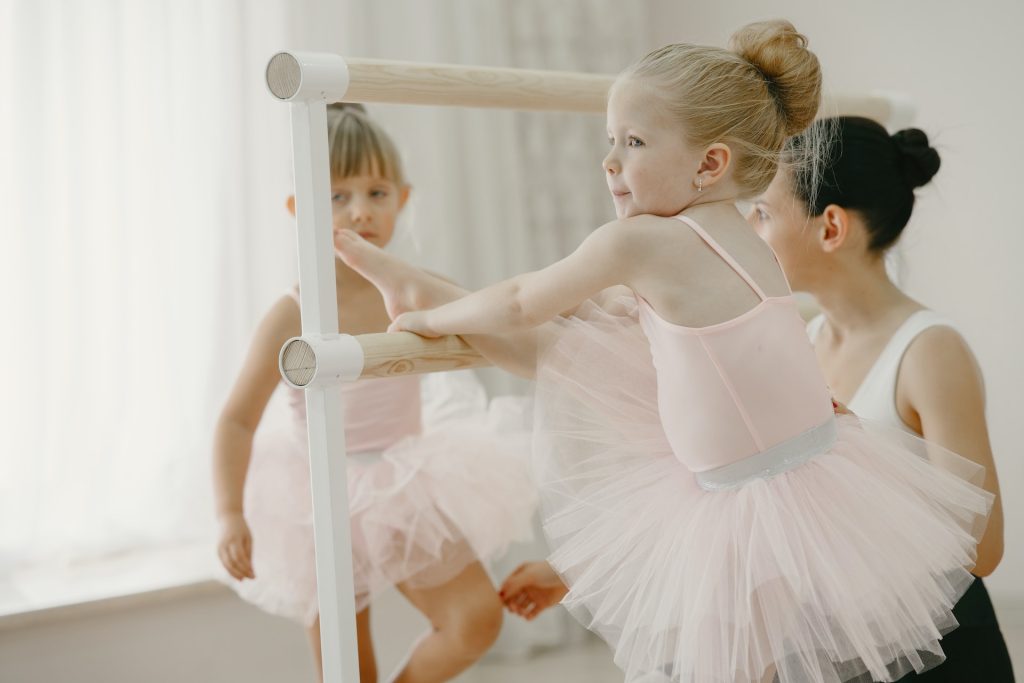Discover effective strategies and tips for teaching dancing to 3-4 year old children.
How to Teach Dancing to 3-4 Year Old Children
If you’re passionate about dance and have a group of energetic 3-4 year olds eager to learn some moves, teaching dance to young children can be a rewarding experience. But where do you start? Fear not, because in this article, we will guide you through the essentials of teaching dance to toddlers.
Understanding the Basics of Teaching Dance to Toddlers

The importance of dance for 3-4 year olds cannot be overstated. Not only does it provide a great way to burn off some of that boundless energy, but it also helps develop motor skills, coordination, creativity, and self-expression. Dance can instill confidence and a love for movement that will benefit children throughout their lives.
When teaching dance to toddlers, music takes on a crucial role. Young children respond to music instinctively, and it helps create a rhythm and structure for their movements. Choose music that is upbeat, catchy, and age-appropriate. Incorporate a variety of dance styles, from ballet to hip-hop, to expose children to different forms of movement.
One important aspect to consider when teaching dance to toddlers is the use of props. Props can add an element of fun and excitement to the dance class, capturing the attention of young children and enhancing their overall experience. For example, colorful scarves can be used to teach children how to move gracefully and create flowing movements. Tambourines and shakers can be incorporated to teach rhythm and coordination. By incorporating props, you can make the dance class more engaging and interactive for toddlers.
In addition to music and props, it is important to create a positive and encouraging environment for toddlers to learn and explore dance. Toddlers thrive in an environment where they feel supported and praised for their efforts. Use positive reinforcement and celebrate their achievements, no matter how small. This will help build their confidence and motivate them to continue learning and improving their dance skills.
Another important aspect of teaching dance to toddlers is incorporating imaginative play. Toddlers have vivid imaginations and love to pretend. Use this to your advantage by incorporating storytelling and role-playing into your dance lessons. For example, you can create a dance routine based on a storybook or have the children pretend to be animals while dancing. This not only makes the dance class more enjoyable for toddlers but also helps them develop their creativity and storytelling skills.
Lastly, it is essential to remember that teaching dance to toddlers should be a fun and enjoyable experience for both the children and the instructor. Keep the atmosphere light-hearted and playful, allowing toddlers to explore and express themselves freely. Encourage them to experiment with different movements and dance styles, and be open to their ideas and interpretations. By creating a positive and nurturing environment, you can foster a love for dance in toddlers that will last a lifetime.
Preparing for Your First Dance Class
Before diving into the dancing fun, it’s essential to create a safe and enjoyable environment for your little dancers. Clear the dance area of any obstacles or hazards, and ensure there is enough space for everyone to move freely. Use colorful mats or tape on the floor to mark dance areas and encourage children to stay within them.
Creating a safe environment is not only important for the physical well-being of the dancers but also for their emotional comfort. Make sure the dance space is well-lit and ventilated, providing a welcoming atmosphere. Consider decorating the walls with inspiring dance posters or pictures to ignite their passion for movement.
Now, let’s talk music. Prepare a playlist ahead of time, ensuring a good mix of songs and dance styles. Consider incorporating different genres like pop, hip-hop, or classical music to expose the dancers to various rhythms and styles. You can even ask the children for their favorite songs and include them in the playlist to make the class more personalized.
As you prepare the playlist, think about the progression of the songs. Start with slower, warm-up tunes to get the dancers’ bodies moving and gradually increase the tempo to keep their energy levels up. Don’t forget to include some cool-down songs at the end to help them relax and stretch their muscles.
In addition to music, consider using props like scarves or ribbons to add an extra element of fun and creativity to the class. These props can be incorporated into dance routines, allowing children to explore different movements and express themselves through flowing fabrics. Not only will this enhance their motor skills, but it will also stimulate their imagination and artistic abilities.
Before the class begins, take a few moments to introduce yourself and establish a positive rapport with the dancers. Encourage them to share their names, favorite dance styles, or any previous dance experience they may have. This will help create a sense of belonging and community within the class, fostering a supportive and inclusive environment.
Get those dancing shoes ready, because your first class is about to begin! Remember to bring extra water bottles for the dancers to stay hydrated throughout the session. Encourage them to wear comfortable clothing that allows for easy movement and bring a positive attitude to embrace the joy of dancing together.
Teaching Techniques for Young Dancers

When teaching dance to toddlers, breaking down dance moves into simple steps is key. Start with basic movements like clapping, tapping feet, or waving arms, and gradually incorporate more complex steps. Use clear, concise instructions and demonstrate each move before having the children try it themselves.
Engaging young dancers through games and activities is a fantastic way to keep them enthusiastic and focused. Incorporate games that encourage creativity, like “freeze dance” or “copycat,” where children mimic each other’s movements. Remember, the goal is to make learning dance a playful and enjoyable experience.
As you introduce dance to young children, it’s important to create a positive and encouraging environment. Begin each class with a warm-up routine that includes stretching exercises and simple movements to get their bodies warmed up and ready to dance. This will help prevent injuries and prepare their muscles for the dance movements ahead.
When teaching dance steps, it’s helpful to use visual aids such as colorful pictures or posters that demonstrate the movements. This visual representation can help children better understand and remember the steps. Additionally, incorporating props like scarves or ribbons can add an element of fun and creativity to the dance class, allowing children to explore different ways of moving their bodies.
Another effective teaching technique for young dancers is to incorporate storytelling into the dance lessons. Choose a theme or a story and create dance movements that correspond to different parts of the narrative. For example, if the theme is “under the sea,” you can teach the children dance moves that mimic swimming, diving, or floating like fish. This not only makes the dance class more engaging but also helps children develop their imagination and storytelling skills.
When teaching dance to toddlers, it’s important to be patient and understanding. Each child learns at their own pace, so it’s essential to provide individual attention and support. Offer praise and positive reinforcement to boost their confidence and motivate them to continue learning and improving their dance skills.
In addition to teaching dance techniques, it’s crucial to foster a love for music in young dancers. Play a variety of music styles and genres during the dance class, exposing children to different rhythms and melodies. Encourage them to express themselves through movement and explore their own unique dance styles.
Lastly, remember that teaching dance to young children is not just about the technical aspects of the movements. It’s about creating a safe and inclusive space where children can express themselves freely and have fun. Encourage their creativity, celebrate their individuality, and let them enjoy the joy of dancing.
Dealing with Common Challenges in Teaching Dance to Toddlers
Teaching dance to toddlers may come with some challenges, but fear not, you’re not alone! Shyness and resistance can be common among young dancers. Encourage a supportive, non-competitive environment where children feel comfortable expressing themselves. Be patient, and provide gentle encouragement to help them overcome any hesitations they may have.
When teaching dance to toddlers, it’s important to remember that their attention spans can be quite short. With an abundance of energy, it can sometimes be challenging to maintain their focus. Incorporating short breaks or fun movement exercises can help refocus their energy and keep them engaged. These breaks can be as simple as having the children jump up and down, wiggle their fingers, or even take a quick stretch. By allowing them to release some of their energy in a controlled manner, you can help them refocus and continue with the dance lesson.
In addition to incorporating breaks, keeping the class dynamic is key when teaching dance to toddlers. Switching activities frequently and providing variety in movements and music styles can help keep the children interested and excited. For example, you can start with a warm-up that involves stretching and basic movements, then transition to a more upbeat dance routine. Introducing different music styles, such as classical, pop, or even nursery rhymes, can also add an element of surprise and keep the children engaged.
Another challenge that may arise when teaching dance to toddlers is the need for repetition. Young dancers often benefit from repeated practice to fully grasp and master new movements. Repetition helps build muscle memory and allows the children to feel more confident in their abilities. Therefore, it’s important to incorporate repetition into your dance lessons. You can break down complex movements into smaller steps and gradually increase the difficulty as the children become more comfortable. By providing ample opportunities for practice and repetition, you can help toddlers develop their dance skills and build their confidence.
Furthermore, it’s essential to create a positive and inclusive learning environment for toddlers. Celebrate their achievements, no matter how small, and provide constructive feedback that focuses on their progress rather than their mistakes. Encourage teamwork and cooperation by incorporating partner or group activities into the dance lessons. This not only helps foster a sense of camaraderie among the children but also allows them to learn from and support one another.
In conclusion, teaching dance to toddlers can be a rewarding experience, despite the challenges that may arise. By creating a supportive and dynamic learning environment, incorporating breaks and variety, emphasizing repetition, and fostering a positive atmosphere, you can help toddlers overcome obstacles and develop a love for dance that will last a lifetime.
Evaluating Progress and Providing Positive Feedback
Recognizing and celebrating improvements in your young dancers’ skills is essential for their self-esteem and motivation. Acknowledge their progress individually and as a group, highlighting specific achievements. Consider hosting mini-performances or family watch days to showcase their newfound dance abilities. Step back and witness the joy and pride on their faces – it’s priceless!
Encourage continued interest in dance by showing enthusiasm and passion for what you teach. Be a role model, expressing your love for dance through your words and movements. Remember, your passion is infectious and will inspire the next generation of dancers!
In conclusion, teaching dancing to 3-4 year old children is an incredible opportunity to introduce them to the world of movement and creativity. By understanding the basics of teaching dance to toddlers, creating a safe and fun environment, implementing effective teaching techniques, and overcoming common challenges, you can ignite a lifelong love for dance in these young dancers. So put on some music, get ready to groove, and let the dancing adventure begin!



